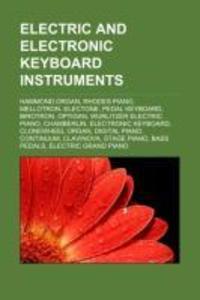
Zustellung: Do, 07.08. - Mo, 11.08.
Versand in 3 Tagen
VersandkostenfreiBestellen & in Filiale abholen:
Source: Wikipedia. Pages: 62. Chapters: Hammond organ, Rhodes piano, Mellotron, Electone, Pedal keyboard, Birotron, Optigan, Wurlitzer electric piano, Chamberlin, Electronic keyboard, Clonewheel organ, Digital piano, Continuum, Clavinova, Stage piano, Bass pedals, Electric grand piano, Pianet, RMI Electra Piano, Electronic piano, Clavinet, Multimonica, Keyboard bass, Clavioline, Tape replay keyboard, Curtis Organ, Rocksichord, Open-Architecture-System, AvantGrand, Yamaha PSR-225, Yongmei YM-490F. Excerpt: The Hammond organ is an electric organ invented by Laurens Hammond in 1934 and manufactured by the Hammond Organ Company. While the Hammond organ was originally sold to churches as a lower-cost alternative to the wind-driven pipe organ, in the 1960s and 1970s it became a standard keyboard instrument for jazz, blues, rock music, church and gospel music. The original Hammond organ used additive synthesis of waveforms from harmonic series made by mechanical tonewheels that rotate in front of electromagnetic pickups. The component waveform ratios are mixed by sliding drawbars mounted above the two keyboards. Although many different models of Hammond organs were produced, the Hammond B-3 organ is most well-known. In the late 1960s and throughout the 1970s the distinctive sound of the B-3 organ (often played through a Leslie speaker) was widely used in Blues, progressive rock bands and blues-rock groups. The last electromechanical Hammond organ came off the assembly line in the mid-1970s. In the 1980s and 1990s, musicians began using electronic and digital devices to imitate the sound of the Hammond, because the vintage Hammond organ is heavy and hard to transport. By the 1990s and 2000s digital signal processing and sampling technologies allowed for better imitation of the original Hammond sound. Hammond B3 organ, and Leslie speaker cabinet.In 1897 Thaddeus Cahill patented an instrument called the Telharmonium (or Teleharmonium, also known as the Dynamaphone). Using tonewheels to generate musical sounds as electrical signals by additive synthesis, it was capable of producing any combination of notes and overtones, at any dynamic level. This technology was later used to design the Hammond organ. About 30 years later American engineer and inventor Laurens Hammond filed U.S. Patent 1,956,350 for a new type of "electrical musical instrument" that could recreate a pipe organ-type sound. He got the idea for the tonewheel by listening to the moving gears of his electric clocks
Produktdetails
Erscheinungsdatum
19. September 2013
Sprache
englisch
Untertitel
Hammond organ, Rhodes piano, Mellotron, Electone, Pedal keyboard, Birotron, Optigan, Wurlitzer electric piano, Chamberlin, Electronic keyboard, Clonewheel organ, Digital piano, Continuum, Clavinova, Stage piano, Bass pedals.
Paperback.
Sprache: Englisch.
Seitenanzahl
62
Herausgegeben von
Source: Wikipedia
Verlag/Hersteller
Produktart
kartoniert
Gewicht
141 g
Größe (L/B/H)
246/189/4 mm
Sonstiges
Paperback
ISBN
9781156078488
Entdecken Sie mehr
Bewertungen
0 Bewertungen
Es wurden noch keine Bewertungen abgegeben. Schreiben Sie die erste Bewertung zu "Electric and electronic keyboard instruments" und helfen Sie damit anderen bei der Kaufentscheidung.










